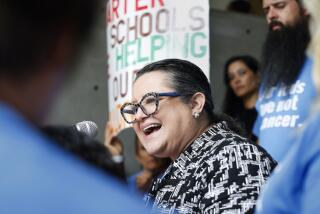Charters draw students from private schools, study finds

Charter schools are pulling in so many onetime private school students that they are placing an ever-greater burden on taxpayers, who must fund an already strained public education system, according to research released Tuesday.
The study by a Rand Corp. economist found that more than 190,000 students nationwide had left a private school for a charter by the end of the 2008 school year, the most recent year for which data was available.
And charter schools have exploded in number since that time. The Los Angeles Unified School District has more charters, 193, than any system in the country.
FOR THE RECORD:
Charter schools: An Aug. 28 article in the LATExtra section about a study of the effects of charter schools on public and private school enrollment referred to Richard Buddin as a Rand Corp. economist. While the study identified him as such, Buddin’s affiliation with Rand ended Jan. 31 and Rand had no role in Buddin’s study. The article also said there are 193 charter schools within the Los Angeles Unified School District. There are 186.
This student migration is especially apparent in large urban areas, where charters are drawing 32% of their elementary grade enrollment from private schools, study author Richard Buddin said. The percentage for middle schools is 23%, and 15% for high schools
Charters are free, independently managed public schools that are exempt from some rules governing traditional schools. Most are not unionized.
About 10% of students nationwide attend private schools — a number that is dropping.
Between 2000 and 2010, for example, the number of students enrolled in Catholic schools declined by 20%, according to church educators. In the final five years covered by Buddin’s study, which looked at data from 2000 through June 2008, more than one-fourth of the students who left Catholic schools enrolled in nearby charters.
The transfer of students from private schools to charters has increased public-funding obligations by $1.8 billion, said analyst Adam B. Schaeffer of the libertarian Cato Institute’s Center for Educational Freedom. Cato paid for the study.
“On average, charter schools may marginally improve the public education system. But in the process they are wreaking havoc on private education …driving some schools entirely out of business,” Schaeffer said.
“For too long, charters have been seen as all positive,” he added. “This reports highlights that there are trade-offs.”
Buddin, who is not affiliated with Cato, was circumspect in interpreting the numbers. He noted, for example, that an influx of politically sophisticated private school families might generate support for increased public school funding.
The study’s findings were no surprise to L.A. Unified school board member Steve Zimmer.
“Parents of means have always had choice when it comes to schools,” he said. “The difference is that with the charter movement, they don’t have to pay for it.”
Most charter students in fact come from traditional public schools. One consequence of that, Zimmer said, has been teacher layoffs within the district. It also has meant less money coming into L.A. Unified, leaving the district with fewer resources to serve its most needy students.
But charter advocates countered that the growth of those organizations was a testament to their academic success and popularity with families, and that the movement should be nurtured and emulated.
“We think we are bolstering the public school system by creating new options within it and showing that it can be reinvented in ways to better serve parents and communities,” said Jed Wallace, chief executive of the California Charter Schools Assn.







